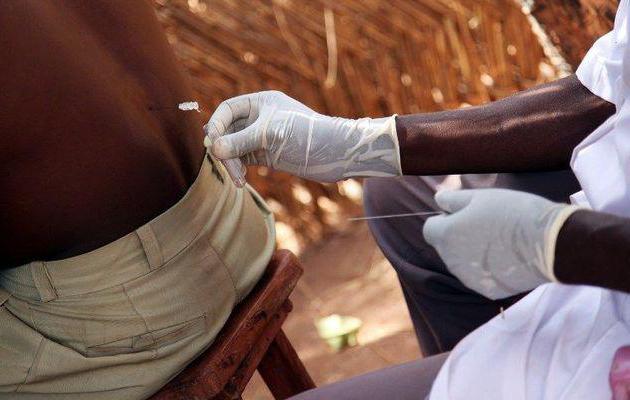It is important for people who travel frequently, and especially travel on the African continent to know about a disease such as sleeping sickness. The causative agent of sleeping sickness - trypanosome - can enter the human body after a bite of a tsetse fly. Recently, there has been a growing tendency to reduce the number of cases of African trypanosomiasis. This is due to many factors, the main of which is the improvement of living standards in these countries.
Causative agent of sleeping sickness
The main carrier of the disease is the tsetse fly. It is worth noting that there are several varieties of the disease. The first type affects animals (both wild and domestic). The Gambian species is characteristic of areas with high humidity (for example, western Africa). The Rhodesian form is most often found in the eastern part, where the climate is drier.
The causative agent of sleeping sickness is eukaryotes, its size does not exceed 20 microns in length. The parasite has an oblong fusiform shape. During the bite of a fly, a huge amount of trypanosomes is betrayed - about 400 thousand. It is worth noting that approximately 400 parasites are sufficient for human infection. A fly is capable of being a carrier throughout its life.
How does infection happen?
When a fly enters the body, the causative agent of sleeping sickness begins to multiply intensively. After a few days, tripomastigotic forms are already present in the salivary glands. There they are modified into a special form - epimastigoty. They are repeatedly divided. The invasive stage (tripomastigoty) is formed by complex morphological changes. A few days after a person’s bite, blood tripomastigitis enters the bloodstream, lymphatic fluid, and then spreads throughout the body. With the further development of the disease, parasites enter the central nervous system. In the brain, the microorganism affects both gray and white matter, causes inflammatory processes, leads to degenerative changes. In an ill person, antibodies to these parasites are detected (usually in the local population). In this case, the disease becomes chronic. For visiting tourists, sleeping sickness is usually quite acute.
Symptoms of the disease
When a fly bites, a chancre forms at the site of the lesion. This is a painful node that itches. It is worth noting that the causative agent of sleeping sickness only in a small amount immediately enters the bloodstream. The bulk remains at the bite site, where it multiplies intensively. The chancre disappears after a couple of days, sometimes a scar remains in its place. In the first period, a person’s sleeping sickness is characterized by the following symptoms: headaches, discomfort in the joints. Also, patients note an increase in lymph nodes. Possible fever and fever. Hemolymphatic stage causes loss of appetite, weakness, heart rhythm disturbance. There are also problems in the work of internal organs. With the Gabmian type, the disease can be unidentified for a long time.
The course of the rhodesian type of sleeping sickness
The Rhodesian form of the disease is more complex and more severe. All symptoms are more pronounced. It should be noted that the causative agent of sleeping sickness of this type to a lesser extent affects the lymph nodes. A few weeks (up to 6) after infection, the central nervous system is affected. This leads to clouding of consciousness, coordination of movements is disturbed, sleep disorders can also be observed: daytime sleepiness increases. Very often, damage to the organs of the cardiovascular system occurs. It is also worth noting that almost immediately after infection with the Rhodesian form of sleeping sickness, the body is depleted. The later stages are characterized by impaired speech, paralysis, possibly coma. In the most severe cases, death can occur (most often from exhaustion, heart problems, concomitant infections).
How is the disease diagnosed? Treatment
Due to the fact that sleeping sickness has causes such as penetration of parasites into the bloodstream, a patient’s blood test is necessary for diagnosis. The presence of live trypanosomes makes it possible to reliably make a diagnosis. You may also need a study of cerebrospinal fluid. This is necessary to determine the stage of sleeping sickness, the proper selection of drugs. It is very important to start treatment as early as possible. In the initial stages, compounds of arsenic, suramin, pentamidine are used. With the Gambian form, eflornithine is effective. The treatment of sleeping sickness with such drugs occurs under the strict supervision of specialists, since all of them are quite toxic and can also cause a number of serious consequences.

How effective the therapy is is judged from blood tests (and cerebrospinal fluid), which must be performed throughout the whole year. This is due to the fact that the parasite can remain viable for a long time, and the disease can relapse even several months after intensive treatment.
How to protect yourself from this disease
First of all, it is not necessary without an emergency need to visit the area where the causative agent of sleeping sickness is found in abundant quantities. If this cannot be avoided, then you should remember about insect repellents. There are special repellents that repel flies, etc. Clothing must be chosen with long sleeves, in light colors. Also during mass outbreaks of sleeping sickness, it is recommended to administer the drug pentamidine. In Africa, deforestation of bushes near settlements is carried out, with the help of chemicals, the Tsetse fly is exterminated. With timely treatment, the recovery of patients reaches 100%. If the therapy was started rather late, or sleeping sickness is caused by the Rhodesian type of parasites, then the forecasts in this case are not so comforting. It is worth remembering that sleeping sickness is a fatal diagnosis in the absence of any treatment.